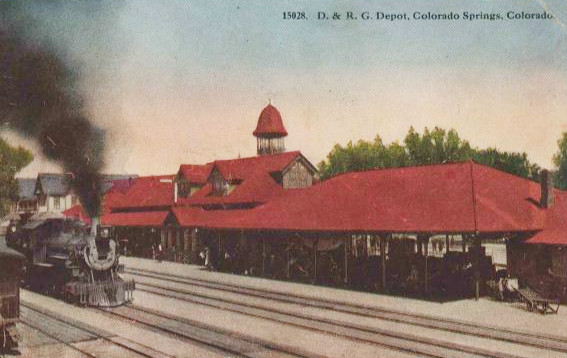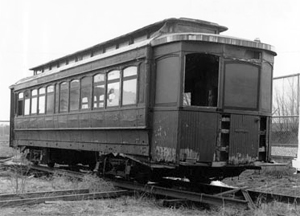-----
 |
| A Denver & Rio Grande Western train arrives at Colorado Springs, 1915. Palmer also founded the D&RGW. (Stauffer and Sons) |
 |
| Brigadier-General William Jackson Palmer, 1870 (Denver Digital Library) |
The first railroads to enter Colorado Springs came in 1871, when former Brigadier-General William Jackson Palmer surveyed the area for possible railroad routes under the Kansas Pacific Railway. While there with Dr. William Abraham Bell, the two men founded the Fountain Colony for the Colorado Springs Company that July just downstream of Colorado City. The name, Colorado Springs, came from four chalybeate (iron salts) springs that would be discovered in 1880 along Monument Creek. Palmer would later found the town of Manitou Springs at the foot of Pike's Peak as a "scenic health resort" in 1872 with Bell, and both towns would be incorporated that same year. Colorado Springs would later be connected by the Colorado & Midland Railway, not the Kansas Pacific, in 1885, but would be swiftly under Atchison, Topeka, & Santa Fe control by 1890.
In 1887, the Colorado Springs and Manitou Street Railway commenced horsecar service between the Springs' business district and local Colorado College (which Palmer also founded). Further expansion north and west of the line required a fleet of ten horsecars, and by 1890, the entire company was reorganized as the Colorado Springs Rapid Transit Railway under new ownership. The new owners would establish the first electric line to Manitou Springs, connecting with the famous Pike's Peak Cog Railway at its base station, and fully electrify the system by October of 1890, phasing out the horsecars. An Eastern extension took the Rapid Transit eastward through Knob Hill and Cheyenne Park to the Santa Fe passenger depot and Harvey House, connecting with the Colorado and Southern as well. By the turn of the century, there were now 44 electric streetcars working the streets of Colorado Springs.
 |
| A Colorado Springs Rapid Transit car arrives at Mineral Springs in Manitou, 1900, it appears to be a Brill standard design. (Leigh Ann Shriver) |
 |
| Winfield Scott Stratton, 1901 (Century Engraving Co.) |
In 1901, the Rapid Transit was now under the ownership of Winfield Scott Stratton. (No relation to the Briggs or Stratton family) Stratton started as a carpenter in Colorado Springs in 1872, but was soon enriched by the Colorado Gold Rush after prospecting in Cripple Creek and founding the Martha Washington and Independence Mine. After the sale of the Martha Washington Mine for a cool $80,000 dollars (basically rich as hell with inflation added), Stratton was further enriched in 1893 when he found a $3 million gold vein (again, rich as hell) and became the first millionaire of the Gold Rush. The Independence mine would be sold for a mean $11 million after Stratton earned $1 million/a year from the mining operations. (Stupid amounts of rich as hell)
However, Stratton didn't sit on his laurels and bask in his wealth; he put his money where it mattered. Seeing the need to give back to the city he began working in, Stratton donated land for the Colorado Springs City Hall, the El Paso Courthouse and the Independence building. He also bought the Rapid Transit for $2 million and intended to improve the system by consolidating it with the neighboring Colorado Springs and Suburban Railway to form the Colorado Springs & Interurban (CS&I). Stratton would not live to see his dear town grow, as he would die in 1902, but his money was put to good use as the system would expand from the new Stratton Park (another land donation turned into a trolley park) to the Roswell coal-town loop, and out to Manitou Springs through new stops in North Colorado Springs, Ivywild, and Broadmoor (all trolley suburb).
 |
| Two new-order cars (one motor, one trailer) displaying the new name of the railway, 1911. (Priscilla Arnett) |
 |
| CS&I 70 bound for Colorado Springs, showing off the open "Narragansett" style with steps but also featuring a rare enclosed driving compartment, 1906. (Denver Library) |
1911 saw peak ridership for the CS&I, but the rapid rise in automobile ownership saw the 38-mile, 56-motor and 13-trailer system in jeopardy. Over the next two decades, the system would continue operations with no fuss or drama, helped along by Stratton's money, but the Works Progress Administration (WPA) would see the end of the Rapid Transit. In 1931, the first buses began replacing streetcars and the last car would run in 1932. By the mid 1930s, the incoming WPA began a repaving operation in Colorado Springs that necessitated the removal of all streetcar track and wire infrastructure. Many of the cars that weren't sold to scrappers found new leases of life in the city they once served as cheap housing.
One of these cheap houses was CS&I No. 48, part of the original 1901 Brill order made by Stratton himself. The car was built as a "convertible", meaning one end could have its windows removed and made an open "summer" section but also brave the harshness of winter. The end platforms also used the novel "Narragansett" folding-step system found on the eponymous holiday streetcars in Rhode Island, meaning passengers didn't have to climb as high to board the car. After retirement in 1932, the car body was used as a residence until 1998, when it was rescued by the Pike's Peak Historical Foundation.
 |
| CS&I 48 prior to restoration, note the filled-in front windows. (HistoryColorado.org) |
The foundation was formed in 1983 by Morris Cafky and John H. Haney, authors of "Pikes Peak Trolleys". In 1990, a local man named Rex Dodson donated CS&I No. 59 to the group, who was now headquartered in an 1888 Rock Island roundhouse in Colorado Springs. Like No. 48, No. 59 was built to the Brill convertible design as the second order, but was actually built by the LaClede company that same year. Both remain the only original Colorado Springs cars left, but the Pike's Peak fleet grew with the addition of Ex-Fort Collins Birney No. 22 (now Colorado Springs 135) and ex-Los Angeles Railway 3101 (a rare P2-type PCC that was one of only 25 built in the US in 1943).
 |
| Ex-Ft. Collins 22's people catcher is serviced, seen through the window frame of CS&I 59, 2019 (Colorado Springs Gazette) |
By this time, restoration work on Birney No. 135 and PCC No. 3101 was being done in preparation for a possible heritage streetcar line to again run from Colorado Springs to Manitou Springs. Despite the monetary and manpower support of the International Brotherhood of Electrical Workers (IBEW), who donated $50,000 for the Birney's restoration, the Colorado Department of Transportation (CDOT) halted all plans for a heritage streetcar line (planned to run as the Colorado Springs and Manitou Traction Co.) due to construction work rebuilding the I-25. Due to being surrounded by railroad right of way, the only other option for the foundation was a short 2-mile street loop by 2010, in cooperation with the local transit authority and the city.
 |
| The current campus of the Pike's Peak Historical Street Railway Foundation, an 1888 Rock Island roundhouse in Colorado Springs, with Los Angeles Railway 3101 at center. (Pike's Peak Historical Street Railway Foundation) |
The Pike's Peak fleet now spans not just the last revenue Birney in America (No. 135) and the last two Colorado Springs streetcars (No. 48 and 59), but also Los Angeles Railway 3101 (which also holds the honor of being the first PCC to operate in Colorado, specifically Cripple Creek), and now nine SEPTA PCCs for eventual heritage streetcar use, as well as one ex-Denver Tramway trolleybus. Still based at the old Rock Island roundhouse, the museum operates on 500 feet of track until they can expand, and is even still franchised by the City of Colorado Springs under "Colorado Springs and Interurban Railway". Though the original is gone, its history continues to live on.
-----
If you enjoyed the information delivered through this blog post, please be sure to visit the Pike's Peak Historical Foundation websites (there's two of them) if you would like to know more or donate to their projects. As usual, you can follow myself or my editor on twitter if you wanna support us, maybe buy a shirt, and on Thursday, we FINALLY take a look at the current crown jewel of Colorado streetcars: the Ft. Collins line! Until then, ride safe!


No comments:
Post a Comment